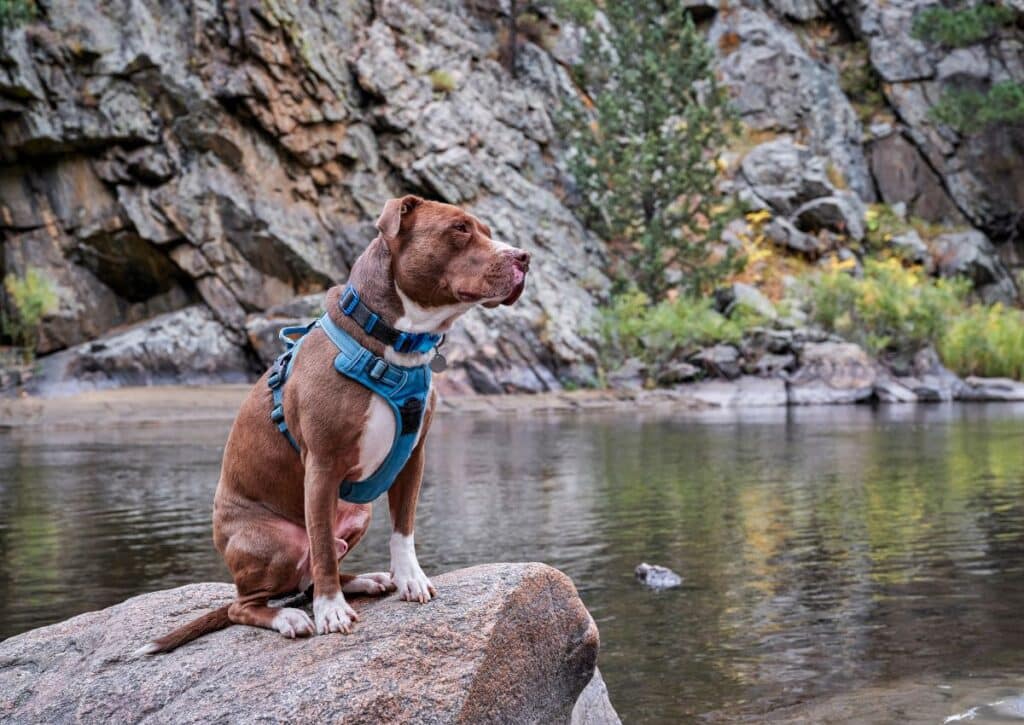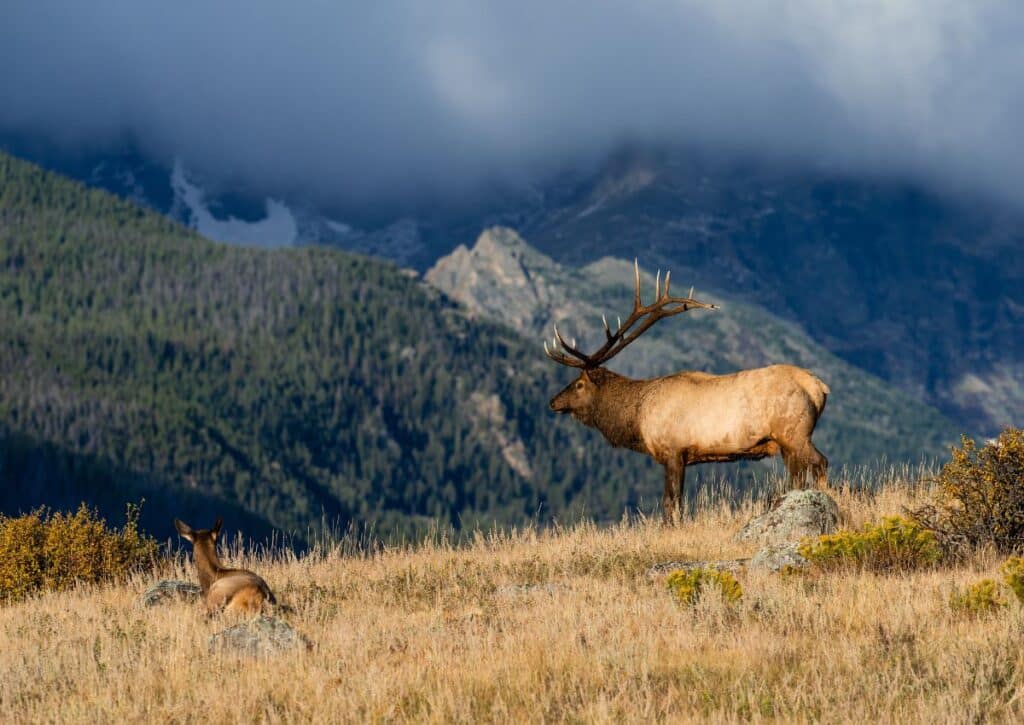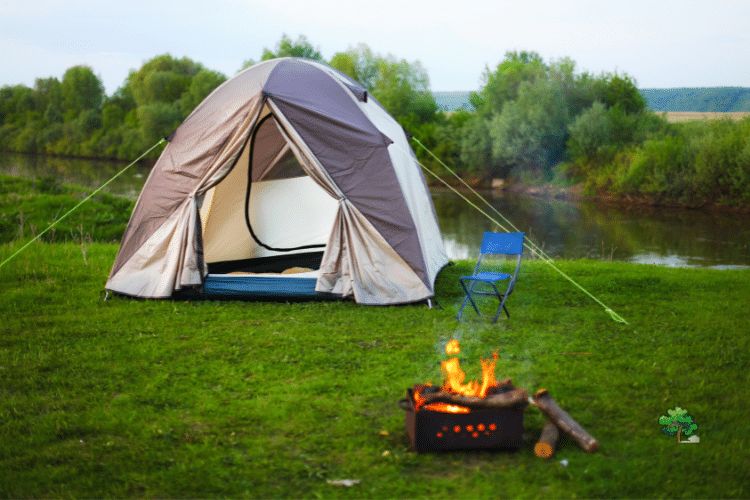Discover dog-friendly tips for Arapaho National Forest: leash laws, trails, and safety.
he Arapaho National Forest, a wilderness haven that beckons outdoor enthusiasts year-round. As you plan your visit to this natural gem nestled in the heart of Colorado’s Rocky Mountains, you might be wondering if your furry freind can come along?
The answer is a resounding “Yes!” In this comprehensive guide, we’ll not only confirm that your furry friend is welcome but also provide you with all the essential information and tips you need for a memorable and responsible adventure with your four-legged companion.
Exploring the Great Outdoors with Your Dog
Arapaho National Forest offers a wealth of opportunities for hikers, campers, and nature lovers, and your dog can be a part of this grand adventure. However, it’s crucial to be aware of the regulations in place to ensure a harmonious experience for all visitors.
In the following sections, we’ll delve into the specifics of these rules, help you prepare for your journey, and provide insights on making the most of your time here while keeping your beloved pet safe and happy.
So, grab your leash, pack your doggie essentials, and get ready to embark on a memorable journey through the pristine beauty of Arapaho National Forest with your furry best friend by your side. Let’s explore the trails, share the fresh mountain air, and make lasting memories in this enchanting wilderness together.
Dog Regulations in Arapaho National Forest
When it comes to bringing your dog to Arapaho National Forest, responsible pet ownership is the key to ensuring a positive experience for both you and the environment. To help you plan your trip effectively, let’s explore the essential regulations and rules you need to know:
1. Leash Requirements
One of the primary regulations for dogs in Arapaho National Forest pertains to leash requirements. To maintain a safe and harmonious environment for all visitors, dogs are generally required to be on a leash at all times.

The leash should not exceed six feet in length. This rule ensures that you have control over your dog and prevents them from approaching wildlife or other hikers in a potentially disruptive manner.
Tip: Invest in a sturdy, six-foot leash before your trip, and consider using a harness to reduce strain on your dog’s neck during hikes.
2. Waste Management
Keeping the forest clean and pristine is a shared responsibility. It’s vital to emphasize the importance of picking up after your dog.
Always carry waste bags and promptly dispose of your dog’s waste in designated trash containers or pack it out with you. Not only is this courteous to other forest-goers, but it also helps protect the environment from contamination.
Tip: Pack extra waste bags and a small shovel in case you need to bury waste in areas without trash facilities.
3. Seasonal Restrictions
Arapaho National Forest, like many natural areas, may have seasonal restrictions or closures in place to protect wildlife during sensitive times. It’s essential to be aware of these restrictions, as they can impact your dog’s visit.
These restrictions often coincide with wildlife mating, nesting, or migration seasons when disturbances can be particularly harmful.
Tip: Check the forest’s official website or contact the local ranger station before your visit to stay informed about any current seasonal restrictions or closures.
4. Special Zones
While Arapaho National Forest is generally dog-friendly, there may be specific areas where dogs are not allowed. These areas are typically designated wilderness zones, where the preservation of the natural environment takes precedence. These zones are off-limits to dogs to minimize human impact on the wilderness.
Tip: Review trailhead signs and maps or inquire with forest rangers to identify any specific zones where dogs are not allowed within the forest.
5. Licensing and Vaccination
Before embarking on your adventure, it’s essential to ensure that your dog is appropriately licensed and up-to-date on vaccinations. This is not only a legal requirement but also vital for your dog’s health and the safety of other animals and visitors in the forest.
Carry proof of your dog’s current vaccinations and licensing information with you during your visit.
Tip: Create a pet information packet that includes your dog’s identification, proof of vaccinations, and emergency contact information in case your dog becomes separated from you.
By adhering to these regulations and guidelines, you can enjoy a memorable and responsible trip to Arapaho National Forest with your dog.
Remember that responsible pet ownership not only benefits the environment but also helps maintain the forest’s appeal for generations of outdoor enthusiasts to come.
Preparing for Your Trip with Your Dog
Planning a trip to Arapaho National Forest with your furry friend is an exciting adventure, but it’s essential to be well-prepared to ensure a safe and enjoyable experience for both you and your dog. In this section, we’ll provide you with practical tips and guidance on how to get ready for your journey into the wilderness with your canine companion.
Essential Gear:
- Leash and Collar with Identification: As mentioned earlier, dogs in Arapaho National Forest must be on a leash that does not exceed six feet in length. A sturdy leash and a well-fitted collar with identification tags, including your contact information, are vital. In case your dog becomes separated from you, this information can help reunite you.
- Waste Bags: Responsible waste management is crucial in the forest. Carry an ample supply of waste bags to clean up after your dog. Ensure that you properly dispose of waste in designated containers or pack it out with you if necessary.
- Water: Staying hydrated is as important for your dog as it is for you. Bring enough fresh water for both you and your dog. Portable dog bowls are handy for providing water to your pup during breaks.
- First-Aid Kit: Just like you carry a first-aid kit for yourself, it’s a good idea to have one for your dog. Include items such as bandages, antiseptic wipes, tweezers (for removing ticks or splinters), and any specific medications your dog may need.
- Appropriate Gear: Depending on the season and activities you plan, consider equipping your dog with suitable gear. In colder weather, a dog jacket may be necessary to keep your pup warm. For hiking, sturdy and comfortable dog boots can protect your dog’s paws from rough terrain.
Training:
Before embarking on your trip, ensure that your dog has basic obedience training. This is essential for the safety of your pet, other visitors, and the local wildlife. Here are some training tips:
- Recall Command: Practice a reliable recall command with your dog, so they return to you promptly when called. This can help prevent your dog from approaching wildlife or other dogs without permission.
- Leave It Command: Teach your dog the “leave it” command to prevent them from picking up potentially harmful items or interacting with wildlife.
- Basic Commands: Ensure your dog responds to basic commands like “sit,” “stay,” and “heel.” These commands will be handy in various situations during your trip.
- Socialization: If your dog is not used to being around other dogs or people, consider socializing them before your trip to help prevent any aggressive or overly excited behavior.
Wildlife Awareness:
Arapaho National Forest is home to diverse wildlife, and it’s important to be mindful of their presence to protect both the animals and your dog. Here’s how to ensure wildlife awareness:
- Keep Your Dog Leashed: Always keep your dog on a leash to prevent them from chasing or disturbing wildlife. Even well-trained dogs can be unpredictable when encountering wild animals.
- Observe from a Distance: If you spot wildlife, maintain a safe distance and avoid approaching them. Use binoculars or a camera with a zoom lens to observe without disturbing.
- Prevent Barking: Excessive barking can disrupt wildlife and other visitors. Train your dog to remain calm and quiet during your outdoor adventures.
- Respect Nesting Areas: During certain seasons, some areas may have restrictions to protect nesting birds or other wildlife. Be sure to adhere to these guidelines.
Safety First:
Ensuring the safety of your dog is paramount during your trip to Arapaho National Forest. Here are some safety considerations:
- Ticks and Fleas: Check your dog for ticks and fleas regularly, especially after hiking through tall grasses or wooded areas. Consider using tick and flea prevention products recommended by your veterinarian.
- Wild Plants: Be cautious of your dog ingesting wild plants, as some can be toxic. Keep your dog from nibbling on unfamiliar vegetation.
- Temperature Awareness: Depending on the season, the weather can vary widely. In hot weather, be mindful of overheating and provide shade and water breaks. In cold weather, protect your dog from frostbite and hypothermia with appropriate gear.
- Emergency Plan: Have a plan in case of emergencies. Know the location of the nearest veterinarian or emergency animal clinic, and carry a pet first-aid kit for minor injuries.
By following these tips and ensuring that your dog is well-prepared and well-trained, you’ll be ready for a safe and enjoyable adventure in Arapaho National Forest. Remember that responsible dog ownership contributes to the preservation of this beautiful wilderness for future generations to enjoy.
Enjoying Arapaho National Forest with Your Dog
Arapaho National Forest offers a plethora of outdoor adventures for you and your canine companion to enjoy together. From breathtaking hikes to serene campgrounds and refreshing water activities, this section will provide you with a comprehensive guide to making the most of your visit to the forest with your dog.
Hiking Trails:
- Diamond Lake Trail (4.4 miles round trip): This picturesque trail, located in the Indian Peaks Wilderness, is a favorite among dog owners. It offers a moderate hike through dense pine forests, with stunning views of alpine lakes and wildflowers during the summer months. Keep your dog leashed to protect the fragile ecosystem along the way.
- St. Mary’s Glacier Trail (1.9 miles round trip): This short but rewarding trail leads to a glacial lake and the St. Mary’s Glacier. It’s a popular destination for families and dog owners. The hike is relatively easy, making it suitable for dogs of all fitness levels. Remember to keep your pup on a leash and bring plenty of water for both of you.
- Hessie Trailhead: Accessible from the town of Nederland, the Hessie Trailhead offers a variety of dog-friendly trails, including the Royal Arch Trail (3.4 miles round trip) and the Lost Lake Trail (4 miles round trip). Be prepared for changing weather conditions and ensure your dog is on a leash at all times.
- Devil’s Thumb Trail (12.3 miles round trip): If you and your dog are up for a challenging adventure, Devil’s Thumb Trail is an excellent choice. It features steep terrain, alpine meadows, and panoramic views. Keep your dog leashed and be aware of potential wildlife encounters.
- Arapaho Pass Trail (7.2 miles round trip): This trail, known for its wildflower displays in the summer, offers a moderate hike with incredible views. Keep your dog on a leash to protect the fragile alpine ecosystem, and bring your camera to capture the beauty of the pass.
Dog-Friendly Campgrounds:
- Arapaho Bay Campground: Situated on the shores of Lake Granby, Arapaho Bay Campground is a fantastic spot for dog-friendly camping. The campground offers beautiful lake views and various amenities, including restrooms and potable water. Be sure to keep your dog on a leash and clean up after them to maintain the pristine environment.
- Pawnee Campground: Located near Brainard Lake, Pawnee Campground is a dog-friendly camping destination offering access to numerous hiking trails. It provides basic amenities such as restrooms and drinking water. Keep your dog leashed while exploring the area.
- Idlewild Campground: Nestled along the St. Vrain River, Idlewild Campground offers a serene camping experience. The campground is dog-friendly, and you can enjoy activities like fishing and hiking. Always keep your dog on a leash and ensure they don’t disturb wildlife or other campers.
- Camp Dick Campground: Situated in the Peaceful Valley area, Camp Dick Campground is a pet-friendly camping option. It provides proximity to trails like Buchanan Pass and Peaceful Valley, where you and your dog can explore the scenic beauty of the forest. Leash your dog, and be mindful of other campers.
- Dispersed Camping: Arapaho National Forest also allows dispersed camping in many areas. While this can be a more rustic experience, it’s essential to adhere to Leave No Trace principles and ensure your dog is well-behaved and under control at all times.
Water Activities:
- Lake Granby: Dogs are welcome at Lake Granby, a vast reservoir known for boating and fishing. Bring your dog along for a day of fishing or rent a kayak or paddleboard and enjoy the calm waters. Keep an eye on your pup and ensure they are comfortable around water.
- St. Vrain River: The St. Vrain River offers various spots where you and your dog can wade, swim, or simply relax by the water. It’s a great place for your dog to cool off on a warm day. Always be cautious of river currents and supervise your dog closely.
- Monarch Lake: Nestled within the Indian Peaks Wilderness, Monarch Lake is a serene spot for a lakeside picnic with your dog. While swimming is allowed, keep in mind that the water can be chilly, even in the summer months. Ensure your dog’s safety if they decide to take a dip.
- Brainard Lake: While dogs are not allowed around the lake, Brainard Lake Recreation Area offers scenic views and hiking opportunities for you and your leashed dog. It’s a perfect place to explore the forested surroundings and enjoy the crisp mountain air.
Pet-Friendly Accommodations:
While camping is a popular choice for visitors with dogs, if you prefer more comfortable accommodations, consider nearby pet-friendly lodging options:
- Hotels and Cabins: Some hotels and cabins in the towns of Nederland, Granby, and Estes Park offer pet-friendly accommodations. Be sure to check their policies and book in advance.
- Vacation Rentals: Look for vacation rentals or cabins in the surrounding areas that are pet-friendly. Websites like Airbnb and VRBO often list such options.
- Pet-Friendly Campgrounds: In addition to the campgrounds mentioned earlier, some campgrounds in the nearby towns may also welcome pets. Check with the campground management for availability and rules.
Before booking any accommodation, confirm their pet policies, fees, and any restrictions they may have, such as size or breed limitations.
By exploring these dog-friendly activities, campgrounds, and accommodations, you can create lasting memories with your four-legged friend in the stunning Arapaho National Forest. Remember to prioritize safety, responsible pet ownership, and respect for the natural environment to ensure a positive experience for all visitors.
Responsible Dog Ownership in Arapaho National Forest
As you embark on your adventure with your four-legged companion in the Arapaho National Forest, it’s essential to uphold the values of responsible dog ownership.

Not only does this ensure the safety and well-being of your dog, but it also helps preserve the natural beauty of the forest and maintain a positive experience for all visitors. Here are some crucial aspects of responsible dog ownership to keep in mind:
Leave No Trace:
One of the fundamental principles of responsible dog ownership in Arapaho National Forest is adhering to the “Leave No Trace” philosophy. This principle promotes environmental stewardship and minimizes human impact on the natural surroundings. As a responsible dog owner, consider the following:
- Pack Out Waste: Always carry waste bags and promptly pick up after your dog. Dispose of waste in designated containers or pack it out with you to maintain the cleanliness of the forest.
- Stay on Designated Trails: Stick to established trails to prevent soil erosion and protect sensitive vegetation. Avoid creating new paths or disturbing the ecosystem.
- Respect Wildlife: Keep your dog on a leash to prevent them from chasing or harassing wildlife. Even friendly interactions can disrupt the natural behavior of animals.
- Minimize Noise: Encourage your dog to remain calm and refrain from excessive barking, which can disturb both wildlife and other hikers.
Respect Other Visitors:
Being considerate of other hikers, campers, and wildlife enthusiasts is crucial to fostering a positive environment for all. Here’s how you can show respect to fellow visitors:
- Leash Your Dog: Ensure that your dog is on a leash at all times, as this is not only a forest regulation but also a courteous gesture toward other visitors who may not be comfortable around dogs.
- Yield the Trail: When encountering other hikers or trail users, step aside with your leashed dog to allow them to pass comfortably. Be friendly and cooperative with fellow forest-goers.
- Ask for Consent: If you come across other dogs or wildlife, always ask for permission from their owners or photographers before allowing your dog to approach or interact.
- Keep Your Dog Under Control: Maintain control of your dog to prevent them from jumping on or approaching strangers without permission. Not all visitors may be familiar with or comfortable around dogs.
Emergency Preparedness:
In the wilderness, being prepared for unforeseen circumstances is essential for both you and your dog’s safety. Here are some steps to ensure emergency preparedness:
- First-Aid Kit: Carry a well-stocked first-aid kit for both you and your dog. Include items like bandages, antiseptic wipes, tweezers for tick removal, and any specific medications your dog may require.
- Emergency Contacts: Keep a list of emergency contacts, including your veterinarian’s information, in case your dog requires medical attention while in the forest.
- Plan for Lost Dogs: Dogs can become separated from their owners, especially in unfamiliar terrain. Attach a visible identification tag to your dog’s collar with your contact information. Consider a GPS collar or microchip for added security.
- Weather Awareness: Be aware of changing weather conditions and how they may affect your dog. In cold weather, bring extra layers for your dog, and in hot weather, provide shade and plenty of water breaks.
- Know the Nearest Veterinary Care: Research the location of the nearest veterinarian or emergency animal clinic to your planned area of exploration in case of a medical emergency.
By embracing responsible dog ownership practices, you contribute to the preservation of Arapaho National Forest’s natural beauty and ensure that future generations can enjoy this pristine wilderness.
Remember that being a considerate and prepared dog owner enhances not only your experience but also the experience of all who share this remarkable outdoor space.
Conclusion
As you prepare to explore the stunning Arapaho National Forest with your faithful canine companion, it’s crucial to remember that dogs are indeed allowed in this natural wonderland, but with specific regulations in place.
Your dog can be your perfect adventure buddy in this forest, provided you follow responsible dog ownership practices and respect the environment and other visitors.
To recap:
- Dog Regulations: Yes, dogs are allowed in Arapaho National Forest, but it’s essential to adhere to the established regulations:
- Keep your dog on a leash no longer than six feet.
- Pack out waste to maintain cleanliness.
- Be aware of seasonal restrictions or closures related to wildlife protection.
- Respect designated wilderness areas where dogs may not be allowed.
- Ensure your dog is licensed and up-to-date on vaccinations.
- Preparing for Your Trip: Equip yourself with essential gear, ensure your dog has basic obedience training, practice wildlife awareness, and prioritize safety.
- Enjoying the Forest: Explore dog-friendly hiking trails, camp at pet-friendly campgrounds, indulge in water activities, and consider nearby pet-friendly accommodations.
- Responsible Dog Ownership: Uphold the principles of Leave No Trace, show respect to fellow visitors, and be prepared for emergencies to ensure a positive and safe experience.
By following these guidelines and embracing responsible dog ownership, you’ll embark on a memorable journey through the natural beauty of Arapaho National Forest. The best part being it’s just a short drive from Denver, making it convenient for pet owners who want an adeventure!
Together with your dog, you’ll create cherished memories while preserving the wilderness for future generations of outdoor enthusiasts to enjoy. So, leash up your pup, pack your essentials, and get ready to make unforgettable moments in this captivating forest.




